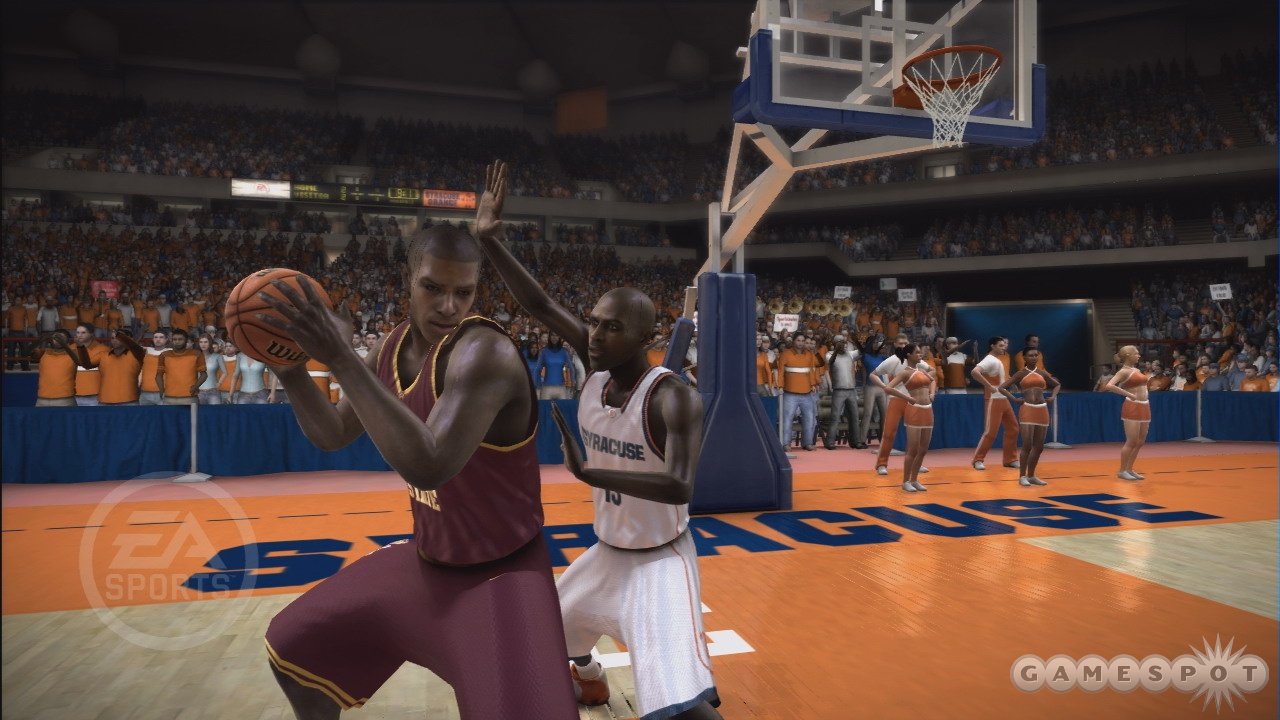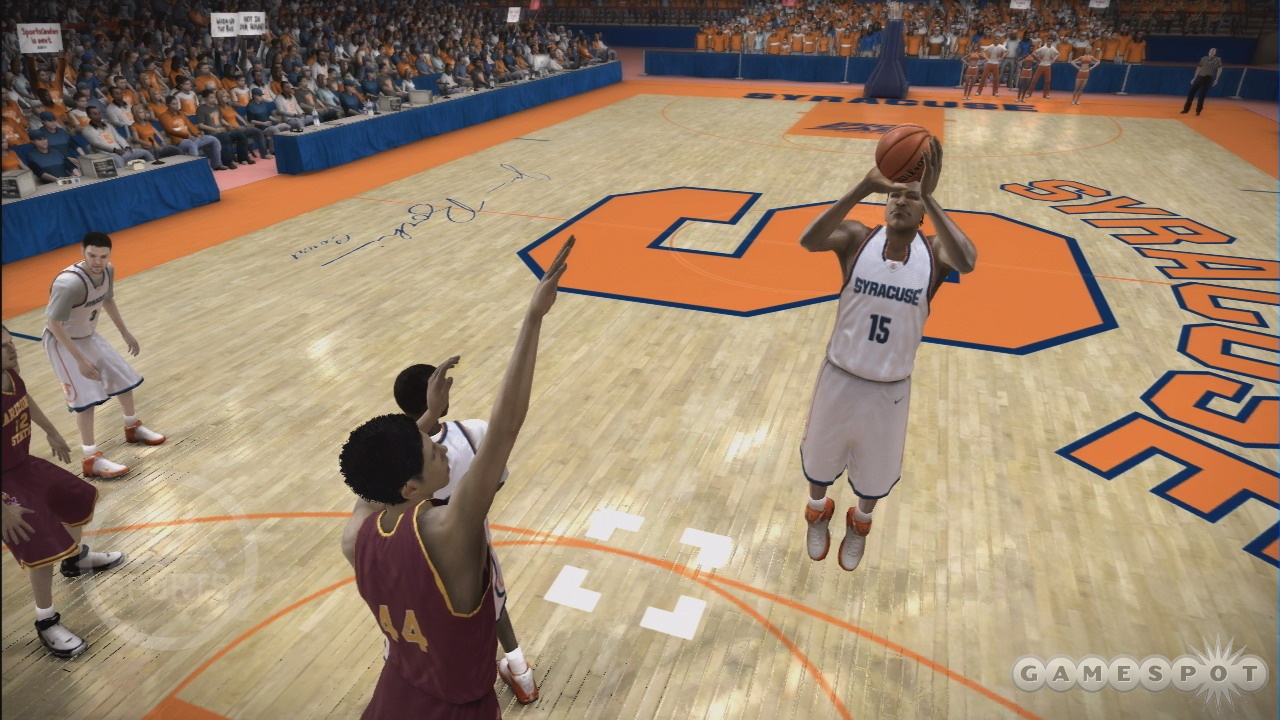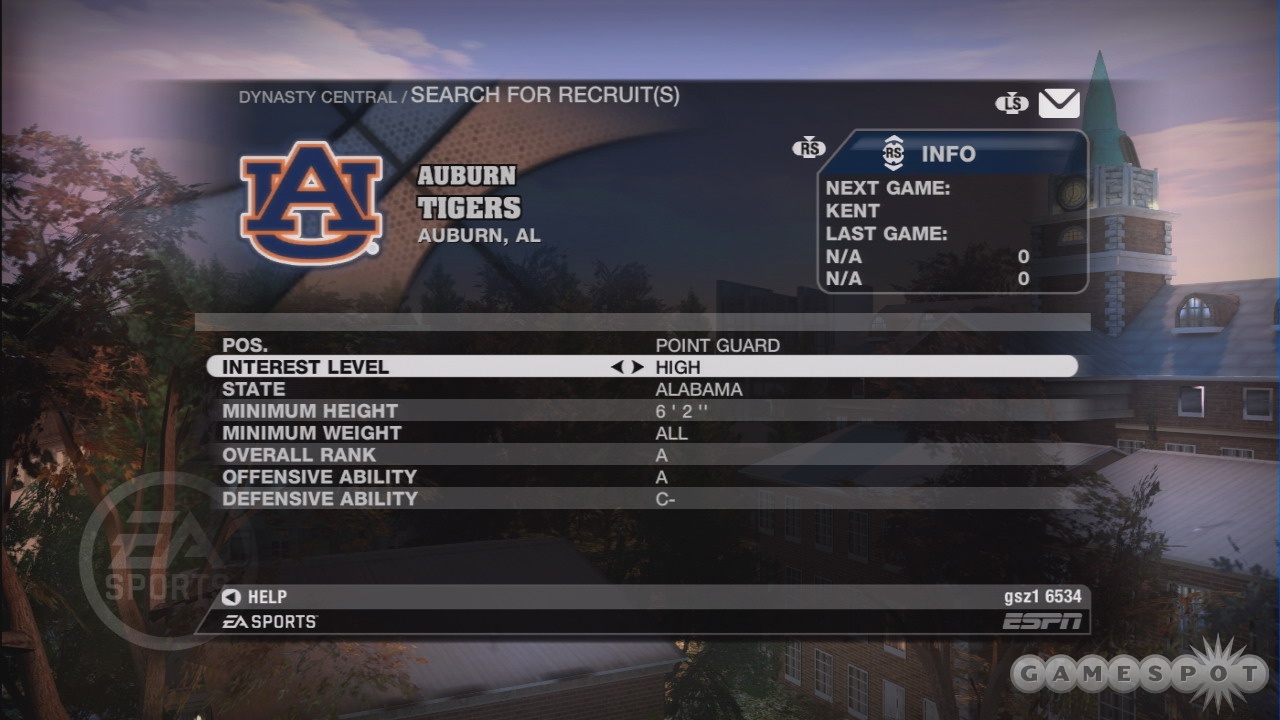NCAA March Madness 08 Updated Hands-On
Low in the post is where the business happens in NCAA March Madness 08. We take a look in our latest preview of the game.
Way down low in the post is where the business happens. It's the most physical part of the basketball court, where shoulders bump, arms are slapped, elbows are registered weapons, and baskets are scored or rejected…hard. It's no place for lightweights; only the brave and the big have any hope of getting things done here, though a little bit of finesse will take you a long way too. Way down here, an old man can meet the end of his career, while a young man can find his just beginning to blossom. It's not just about physicality, though. A wise player down low can make a freshman look like he's standing still. Welcome to the new post play in NCAA March Madness 08, where the business happens.

On the court, the new post controls are the primary point of interest to longtime fans of the series, if for no other reason than the immediate effect it has on how you play the game. For what feels like the first time in series history, playing down in the low block isn't just a legitimate strategy, it can also be fun. Once you pass the ball to your forward or center down low, you'll have a number of options at your disposal to try to get the ball through the hoop. The first, and perhaps most obvious option, is to get around your defender. To do so, you can push either left or right with the right analog stick to try to wrap your player around the defender and charge the basket.
The animations during low-post moves like this are nice, and obviously, the developers at EA Sports spent some time working on them. A player on offense will move his arms around a defender, trying to shove him out of the way. If you're being guarded in an especially tough way, you might find your player ducking underneath the coverage and trying to force his way toward the basket. In addition, slippery point guards are adept at squeezing in between two pressing defenders with some slick animations. The defender, on the other hand, will do his best to grind his shoulder down low and get in the way of his progress. By the way, those defending animations play into low-post defense as well (more on that in a bit).
Even if you can't get around your defender, you can still attempt a shot down low. Pressing the B button will make your player take a shot over the defender's head, but taking a shot while moving the left analog stick away from the basket will result in a fadeaway shot. For big men down low, the X button will be your best friend because that's the button used for sky hooks, which can be unstoppable when used at the right moment. Go ahead and unleash your hidden Lew Alcindor; your team will thank you for it.
When defending down low, your skill with the analog sticks will count for a lot. You can choose your position when defending the pass--playing behind or in front of the offensive player you're guarding and even going for the steal in the air by pressing the X button or right trigger. While the risk versus reward of this tactic is pretty high, using the left analog stick when you're being backed down in the post is both intuitive and fun. If you're being backed up and your offensive player spins toward the basket, you simply flick the stick in the same direction he's heading to attempt cutting him off. If you get the hang of this, you'll be a dominant defensive power down low and force your opponent to rethink his strategy on the court.
Of course, the same applies to you. Even at the default difficulty setting, you go to the post-play well too many times and the artificial intelligence in March Madness 08 will get wise. Sooner or later, the AI will be doubling up your big men. These double-team situations (whether on defense or offense) happen often and (all too) commonly result in stripped balls if you can't get an outlet pass off in time. Nonetheless, it's indicative of how you play March Madness 08. At first, you're automatically drawn to the new controls for play down low; however, sooner or later, you'll learn that NCAA championships aren't just built on play in the paint because the AI forces you to open up your game and try shots outside of five feet.

While the game down low feels different, much of March Madness 08 will be familiar to those who played last year's game. The composure ratings of players still plays into your team's success during games. If you build up enough composure through successful plays on the court, you can initiate impact moments, which are small interactive cutscenes where you can pump up the crowd or your teammates. Depending on the kind of guy you are, you can also thumb your nose to the opposition. In addition, the graphics, particularly the player models, show offer a fine degree of realism and variety that really adds to the game's presentation quality. The trio of Brad Nessler, Dick Vitale, and sideline reporter Erin Andrews provide audio duties this year (for more with Erin, check out the audio interview above).
NCAA March Madness 08 game modes include the quick match option, as well as three tournaments to compete in: the Maui Invitational, the NIT Season Tip-Off, and, naturally, the Big Dance itself, the NCAA Tournament. The tournaments and quick play modes are fine, but true hoop-heads will want to immerse themselves in the game's dynasty mode. Some aspects of last year's game return for better or worse. On the plus side, the campus challenges that let you add to your school's facilities by winning certain key games return and are still a compelling feature. On the other hand, actual team schedules aren't in the game, which means you'll need to spend some time in the schedule customization menu to re-create your team's actual 2007/2008 lineup.

Naturally, the biggest aspect of a dynasty mode is recruiting and, this year, the new system has received an upgrade thanks in part to another college sports game from EA: NCAA Football 08. That game had a much improved tool for finding specific players who would complement your team based on your needs, and the system now finds its way to March Madness. A recruiting database will be your go-to point when looking for players. You can use it to search for players along such criteria as position, interest level, state (pipeline states factor in, just as they do in NCAA Football), overall rank, defensive or offensive ability, and more. With all of these variables at hand, it can sometimes be difficult to find a player you're looking for if you get too narrow with your selection criteria; you quickly learn how to narrow down your search and then hone in on specific players from the results given.
As with every college program, a coach's opinion isn't the only one that counts when it comes to recruiting. Thanks to a new feature called the recruiting challenge, you'll be getting advice from your athletic director on just the kind of players you need to try to recruit. Often times, these players will be right in line with your team needs (a summary screen of which you can view at any time while recruiting).
What makes recruiting challenges compelling is the specificity of the challenges. For example, out of five recruiting challenges for a season, two might ask you to sign players at a specific position, one might ask you to grab a player whose defensive rating is a C+ or higher, and the other two might be looking for players who have an "average" potential rating. As a result, you might be able to kill two (or more) recruiting birds with one stone (by, say, recruiting a point guard with great potential and a B+ defensive rating). You can check your progress against these recruiting challenges throughout the year, and the screen keeps you aware of which recruits you've targeted that meet any of these criteria.
Once you have a few target players to focus on, it will be up to you to convince them to play for your school. To do so, you'll have an allotment of recruiting points, which you budget at the beginning of the year against other important school considerations, such as game plan and discipline. You'll spend points on such things as researching players on the Internet, sending them letters of interest, calling high school coaches to pitch various aspects of your program (such as locale, playing time, program prestige), and making actual visits to that player. This recruiting pool of points is your entire allotment for the season; if you use them up too early, you won't be able to nab any players who might develop interest in your program toward the tail end of the year. However, recruiting isn't a chore. In fact, we had relatively little trouble grabbing the players we wanted midway through the season. Curiously, even though our scholarships were used up for the year, we still received notices from interested alumni and high school coaches willing to help out with recruiting--even though we weren't in a position to do anything about it.

Beyond recruiting, there's still the matter of winning games, as well as making sure your program continues on the NCAA straight and narrow. For the former, you can spend some of your budgeted game plan points on scouting opposing teams and players. You can also learn their tendencies and better prepare for your upcoming matches (crucial, especially once conference play begins). When it comes to discipline, you'll periodically be notified if your player violates NCAA rules (forget the police blotters and salacious newspaper headlines, however, these infractions rarely rise above the academic variety). Even so, as coach, it's up to you to spend whatever points you've allocated toward discipline to punish your player; thus, lessening NCAA scrutiny of your program. As in the past, it still feels weird to spend points on suspending a player (shouldn't the fact that the player is off the roster be punishment enough?), but if you want to avoid the all-knowing, all-penetrating gaze of the NCAA, you'll do well to be firm with your discipline.
Whether you're working the recruiting circuit or working the ball down low in the post, NCAA March Madness 08 looks to keep college basketball fans busy when it's released in December. Stay tuned for more on the game in the near future.
Got a news tip or want to contact us directly? Email news@gamespot.com
Join the conversation